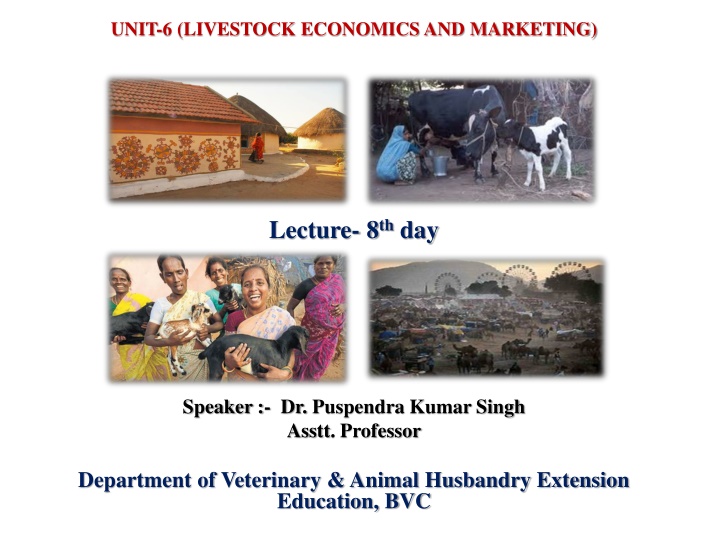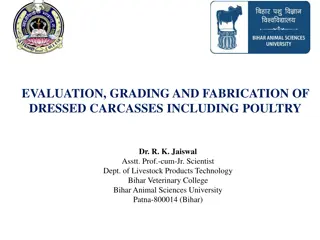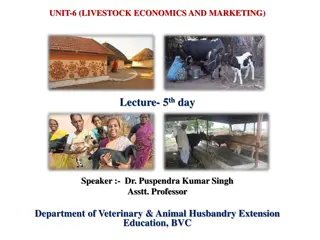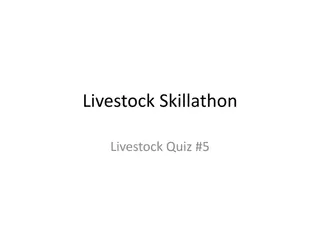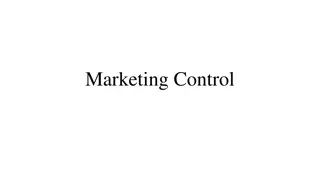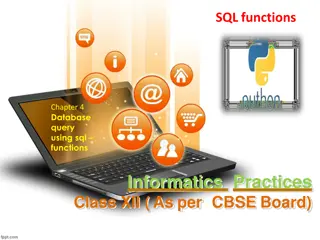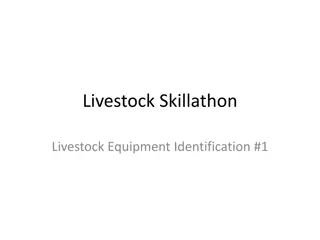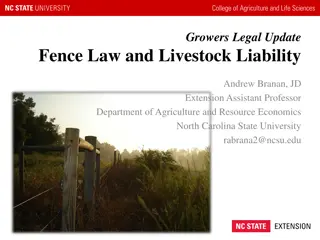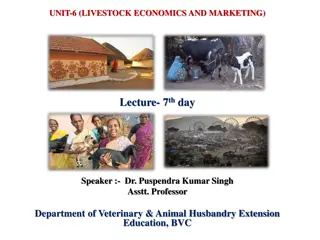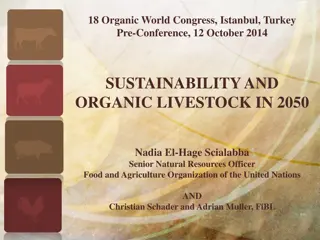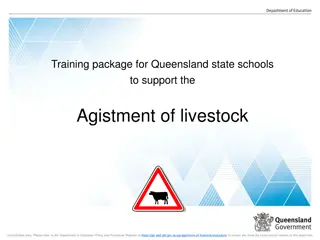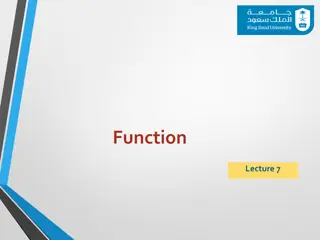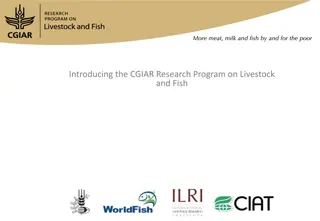Livestock Marketing Functions and Classification
Livestock marketing involves various functions such as exchange, physical supply, facilitative functions like grading, transportation, storage, and more. These functions are classified into primary, secondary, and tertiary functions based on their roles. Assembling, processing, distribution, and equalization are primary functions, while buying, selling, and facilitating functions like risk bearing and financing are secondary functions. Tertiary functions include banking, insurance, and communication, aiding in the marketing process. Awareness of these functions is crucial for effective livestock marketing strategies.
Download Presentation

Please find below an Image/Link to download the presentation.
The content on the website is provided AS IS for your information and personal use only. It may not be sold, licensed, or shared on other websites without obtaining consent from the author.If you encounter any issues during the download, it is possible that the publisher has removed the file from their server.
You are allowed to download the files provided on this website for personal or commercial use, subject to the condition that they are used lawfully. All files are the property of their respective owners.
The content on the website is provided AS IS for your information and personal use only. It may not be sold, licensed, or shared on other websites without obtaining consent from the author.
E N D
Presentation Transcript
UNIT-6 (LIVESTOCK ECONOMICS AND MARKETING) Lecture- 8thday Speaker :- Dr. Puspendra Kumar Singh Asstt. Professor Department of Veterinary & Animal Husbandry Extension Education, BVC
Topics covered Marketing functions .
MARKETING FUNCTIONS Function of Exchange Function of Physical supply Facilitative Function a. Grading and (a) Buying (a) Transportation standardization (b) Selling (b) Storage and warehousing b. Financing c. Packing and packaging d. Risk bearing figure 1
Marketing functions have also been classified as: 1. Primary functions : These include assembling, processing, distribution and equalization. 2. Secondary functions : These include all the functions listed in figure 1, except the facilitating functions like risk bearing, market information and financing. 3. Tertiary functions : These include facilitating functions as listed in figure 1, viz. banking, insurance and communication.
1. Assembling : This involves collection of produce from small and large producers scattered over a large area. 2. Processing : This implies increasing the value of the product by changing the form, colour, taste of the product. It is an important function in present day marketing of farm produce. This activity involves a change in the form of the commodity. Processing converts raw materials and brings the products nearer to human consumption. Processing also makes it possible to store perishable commodities. 3. Distribution : This function is concerned with making available the product to other market functionaries and to final consumer. 4. Equalization : This involves adjustment of the supply to the demand and it is an important function in holding commodities with seasonal production.
5. Buying and selling : Buying and selling are the two important functions involved in the transfer of ownership. a. Buying : Buying includes identifying one's needs, finding the source of supply of products and processing them at the right price, at the right time and in the right quantities. The sub-functions of buying are: i. Function of planning the purchase: Planning the needs, surveying the markets and deciding the quality and quantity if goods. ii. Contractual function: Identifying sources of supply to confirm the supplier of a good and establishing contact with them. iii. Function of negotiation: Negotiation of terms and conditions of purchase with the sellers. iv. Final agreement and transfer of goods : Once negotiations are completed, the goods are transferred to the buyers.
b. Selling : Selling is the process of finding the buyers and convincing them to buy the product at a price that is satisfactory to both sellers and buyers. The sub-functions of selling are : i. Product planning and development : This activity starts right from determination of the needs of the consumers, the various attributes of the products preferred by them, actual production of the products, their grading and also deciding about brand names under which to sell the product. ii. Contractual function : Identifying the potential consumers for the product and initiating and maintaining contacts with them for selling the product. iii. Demand creation: Introduction of various selling techniques so as to stimulate the consumers to buy the product. This includes both sales promotion and advertising techniques. iv. Function of negotiation : Consideration of important factors at the time of selling, for example quantity and quality of the product to be transacted, time of transfer, particulars of packing, terms of payment and mode of delivery.
Transportation : Transportation crates place utility. The need for transportation arises because most of the goods are not consumed at the point of production. Transportation helps in 1: Expansion of market (milk products under the brand name of AMUL are produced in Anand, Gujarat, but are available all throughout the country) 2: Reduction of spatial price differences (transportation of milk from milk shed areas through the national milk grid to milk deficient area, helps in reducing price fall in surplus areas and price rise in scarcity areas). 3: Provision of employment (in various transportation functions like driving, loading and unloading and even construction of roads) 4: Overall development of the economy (by facilitating movement of raw materials from rural areas to industrial areas and movement of manufactured commodities from industries to rural areas).
Storage and warehousing Storage creates time utility. Storage of goods therefore ensures a continuous flow of goods throughout the year and enables the producers to reap the associated price advantage. Storage may take place along every stages of marketing chain. Storage is associated with some risks as well. These are quantity loss as a result if moisture loss, presence of rodents, pests, insects and even thefts, fire and quality loss again to pests and insects, presence of excessive moisture and/or temperature. Faulty storage too, sometimes contributes to forage loss.
Warehouses are scientific storage structures, especially constructed for the protection of the quantity and quality of stored products. Keeping it mind the importance of preventing physical damage and quality deterioration in agricultural produce, the central warehousing scheme was launched by the central government on priority basis. The main objectives of warehousing are: 1. To reduce wastage in storage of difference commodities; 2. To assist in orderly marketing of agricultural commodities by introducing standard grade specifications; 3. To issue warehouse receipt on the basis of which commercial banks advance credit to producers and dealers 4. To assist the government in price support operations.
Grading and standardization Establishment of basic measures which the produced commodities must conform to. Standardization precedes grading. Standardization means the determination of the standards to be established for different goods. Standard specifies what basic quality a product must have to be consistent with the established characteristics. 'What is the need for standardization? The objective of standardization is to overcome the above problem by having fixed standards which are universally accepted and followed by all in the trade.
Grading means the sorting of produce into different lots having the same characteristics with respect to quality specifications. It is the act of separating lots of commodities according to already set standards. Grading follows after the standards are set (standardization). The advantage of grading is that it enables farmers who produce quality goods to fetch a premium price for their produce.
Packing and packaging Packing and packaging are required for moving the products along the marketing chain, i.e. from farm gate (point of production) to traders (wholesalers, retailers, etc.) and finally to the ultimate consumers. The type of packing material varies from commodity to commodity as well as the stage in the marketing chain, Gunnies are generally used packing means for agricultural produce like cereals, oilseeds, limes, pulses and even vegetables. Fish is packed in baskets, oil in sachets and tins, milk in plastic sachets and even tin or glass containers and fruits in wooden or bamboo baskets.
There is a difference between packing and packaging. Packing means wrapping or crating of commodities so that they can be transported. Packaging is a part of packing. Packing is putting the goods in small packages like bags, sachets, bottles, etc. for sale to ultimate consumers. For example, putting milk in 0.5 Kg or 1 Kg plastic pouches so that it is convenient for consumers to purchase is packaging and when several such pouches are kept is a single crate for transportation is packing.
Financing Both the market intermediaries as well as producers need financial existence in the marketing process. Producers often find it difficult to run their farm enterprise with their owned funds. They, thus, from time to time require financing from external sources not only for scaling up production (like purchase of capital assets like dairy animals, for instance), but also for meeting daily operating expenditure (like expenditures on feed and fodder). Apart from production credit as mentioned above, producers also need market finance before they can dispose the produce at a favourable price for various marketing functions like packaging, processing, storage, etc. Distress sales are averted if adequate marketing finance is given to the farmers.
Risk bearing There is always a time lag between the production and ultimate consumption. There is a certain degree risk involved during this time lag which is borne by producers, traders and other intermediaries involved in the marketing process. 'Risk bearing' may be defined as accepting the possibility of loss when marketing a product.
The risks associated with marketing are of following types: 1. Physical risks : These risks consist of loss of quantity as well as loss of quality. This may arise due to fire, pest infection, excessive moisture or temperature, theft and even inadequate packaging. These losses may occur during various stages of marketing process like weighing, bagging, transportation, storage, etc. 2. Price risks : Price risk is an important source of risk in marketing of agricultural produce including livestock produce. Price may rise or fall during the course of time. 3. Institutional risks : These risks arise from changes in government policies like movement restrictions of agricultural produce, imposition of levies, statutory price control, etc. 4. Changes in tastes and preferences of consumers also pose risks before the producers and marketers. 5. Natural calamities like flood, war and even riots/arson also are important sources of risks in marketing.
Measures to reduce risks 1. Improving storage mechanisms : Physical losses can be reduced by bringing suitable changes in storage structures at the producers' level. This can be done by refrigeration, pre-storage treatment, fire-proof materials in storage structure, etc. 2. Insurance : Insurance companies provide risk cover to producers during the periods of quantity losses during marketing. 3. Minimization of price risks : Price risks may be minimized by i. Fixing minimum and maximum prices of commodities (also known as minimum support and ceiling prices, respectively) ii. Future contract with commission agents, wholesalers, buyers and professional speculations iii. Establishing a mechanism for effective dissemination of scientific market information to all stakeholders in the marketing process.
Arbitrage Arbitrage is the practice of taking advantage of a price difference between two or more markets and considered as an opportunity to buy an asset at a low price then immediately selling it on a different market for a higher price which helps an investor to have a risk free profit at zero cost or low costs.
Hedging A technique of managing price risk. It is used to minimize or eliminate the probability of substantial loss or profits due to movements in the price of the underlying asset (i.e. A commodity or financial instrument), suffered by an investor. This is possible only by holding contrary positions in two different markets to counterbalance the risk of loss. Therefore, if there is a loss/gain in the cash position because of the price fluctuations, it can be offset by the movements in the prices of a futures position. BEST WAY TO DESCRIBE HEDGING IS INSURANCE OF RISK
Speculation Process of buying and selling of an asset incorporating considerable risk, in the hope of generating good returns from an anticipated change in the price level. Speculators perform speculation, in an attempt to earn profit from the changes in the difference between future price and spot price, as they bet on their difference. Hence, the risk is taken intentionally to reap profits.
Key Differences Between Hedging and Speculation Hedging is the act of preventing an investment against unforeseen price changes. The process in which the speculators trade in an underlying asset of the high-risk element, in order to earn profits, is known as speculation. Hedging is a means to control or eliminate risk. Conversely, speculation depends on risk, in the hope of making good returns.
Hedging offers protection against undesired price fluctuations. On the other hand, Speculation involves incurring risk to generate profits from price changes. Hedgers are risk averse, who secure their investment through hedging. Speculators are risk lovers, who take risks deliberately and play a critical role in providing liquidity in the market.
